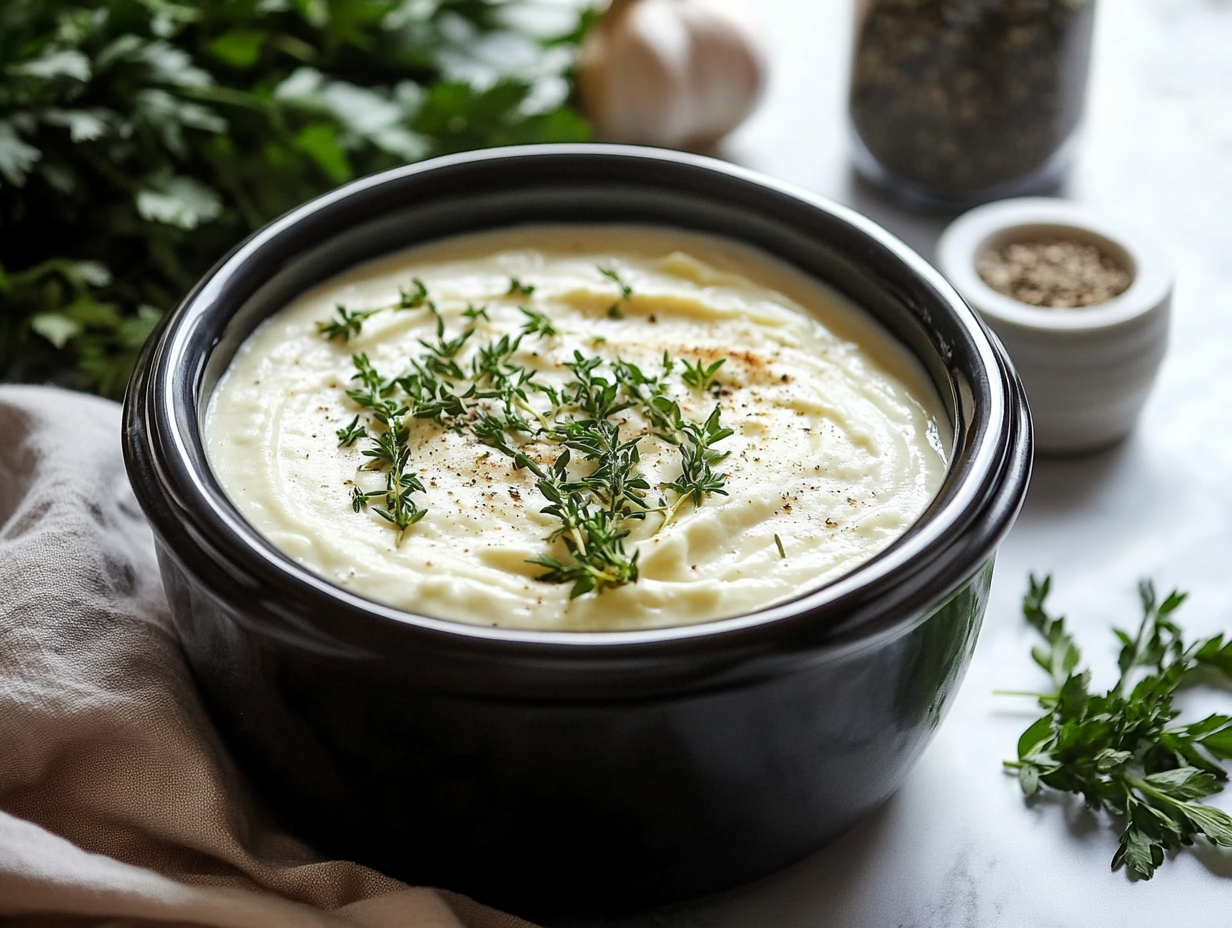Why Did My Cream Cheese Curdle in Crock Pot?
Cooking with cream cheese can be a delightful way to add richness and creaminess to your meals, but encountering curdling in the crock pot can be frustrating. This article will explore the science behind why did my cream cheese curdle in crock pot, the factors contributing to it, and how to prevent this mishap. By the end, you’ll have the tools to master dairy-based recipes with confidence.
Part 1: Understanding Cream Cheese and Curdling
What Is Cream Cheese?
Cream cheese is a soft, fresh cheese made from a blend of cream and milk. Its smooth, creamy texture and slightly tangy taste make it a versatile ingredient in both savory and sweet dishes. Thanks to its high fat content and emulsifiers, it melts well—if treated correctly.
Properties of Cream Cheese
- Fat Content: Cream cheese typically contains about 33% fat, which gives it its creamy consistency and rich flavor.
- Emulsification: The fat and water in cream cheese are bound together by emulsifiers, creating a stable product. However, under certain conditions, this stability can break down, leading to curdling.
The Science Behind Curdling
Curdling happens when the proteins in cream cheese separate from the liquid, forming lumps. This is often caused by factors like heat, acidity, or a combination of the two. While it might seem like magic—or a mishap—it’s all science at play.
Factors Leading to Curdling
- High Heat: Overexposure to heat can denature the proteins, breaking their bonds and causing separation.
- Acidic Environments: Adding ingredients like tomatoes or vinegar can disrupt the balance, making the cheese curdle.
Understanding these causes is key to crafting recipes where cream cheese remains smooth and creamy.
Role of Emulsifiers in Dairy Products
Emulsifiers in cream cheese, such as guar gum or xanthan gum, play a critical role in maintaining its stability. However, even these helpful additives can falter if the temperature or acidity in your dish is extreme.
Part 2: Factors Contributing to Curdling in Crock Pots
4. Heat Exposure in Slow Cooking
Temperature Ranges in Crock Pots
Crock pots operate at two primary settings:
- Low (170°F–200°F): Ideal for slow, gentle cooking.
- High (200°F–300°F): Speeds up cooking but risks overheating sensitive ingredients like dairy.
While cream cheese can tolerate some heat, prolonged exposure at higher settings can cause its proteins to denature and separate.
Impact of Prolonged Heat on Cream Cheese
- Protein Denaturation: When exposed to excessive heat, the proteins in cream cheese lose their structure and separate from the fat and water. This leads to curdling, where visible clumps form in your dish.
- Moisture Loss: High heat evaporates liquid, concentrating the proteins and accelerating curdling.
How to Manage Heat:
- Always add cream cheese at the end of the cooking process.
- Use the low setting for recipes involving dairy.
- Monitor the temperature with a food thermometer to ensure it doesn’t exceed 170°F.
5. Influence of Acidity on Cream Cheese Stability
Acidic Ingredients in Recipes
Commonly used acidic ingredients like tomatoes, vinegar, lemon juice, and wine can destabilize cream cheese in crock pot recipes. Examples:
- Tomato-based sauces in pasta dishes.
- Vinegar in stews or soups.
Chemical Reactions Leading to Curdling
- Protein Precipitation: Acids lower the pH level of the dish, altering the proteins in cream cheese. This results in clumping and a grainy texture.
- Synergistic Effect: Heat combined with acidity magnifies the risk of curdling, making proper ingredient handling crucial.
How to Balance Acidity:
- Add acidic ingredients gradually and blend thoroughly with other components.
- Consider using cream cheese with a higher fat content, as it resists curdling better in acidic conditions.
6. Importance of Ingredient Integration
Proper Mixing Techniques
How you incorporate cream cheese into your crock pot recipe can significantly impact its stability:
- Softening the Cream Cheese: Soften cream cheese at room temperature before adding it to the dish.
- Cubing: Cut the cream cheese into small pieces to ensure even melting.
- Gradual Incorporation: Stir the cream cheese slowly into the dish, allowing it to melt gradually without clumping.
Consequences of Improper Mixing
- Localized Curdling: When cream cheese isn’t evenly mixed, hot spots can form, leading to curdling.
- Uneven Texture: Improper blending results in some parts of the dish being creamy while others are lumpy.
Tips for Proper Integration:
- Use a whisk or immersion blender to achieve a smooth consistency.
- Avoid stirring vigorously to prevent breaking the emulsion.
By understanding these factors, you can craft recipes that balance heat, acidity, and ingredient integration to keep your cream cheese dishes creamy and delicious.
Part 3: Preventing Cream Cheese Curdling in Crock Pot Recipes
7. Best Practices for Adding Cream Cheese
Timing of Addition
The timing of when cream cheese is added can significantly influence its stability. Adding it too early exposes it to prolonged heat, increasing the risk of curdling.
- End-of-Cooking Addition: Introduce cream cheese during the final 20-30 minutes of cooking. This ensures it melts gently without overheating.
- Step-by-Step Tip: Turn the crock pot to the low setting or off completely when adding cream cheese to retain its creamy texture.
Preparation Methods
- Softening: Bring cream cheese to room temperature before using it. Softened cream cheese blends more easily and melts evenly, reducing the risk of curdling.
- Cubing: Cut the cream cheese into small cubes to facilitate quicker melting and smoother integration into the dish.
8. Managing Cooking Temperatures
Optimal Settings for Dairy-Based Dishes
Maintaining a low temperature is crucial when preparing dairy-based dishes in a crock pot.
- Low Setting: Stick to the low setting, which usually operates at 170°F–200°F, to prevent protein denaturation.
- Avoid Boiling: High temperatures can cause cream cheese to curdle rapidly.
Monitoring and Adjusting Heat Levels
- Use a Food Thermometer: Keep the temperature below 170°F to protect dairy ingredients.
- Layering Ingredients: Place cream cheese in the center of the crock pot, away from direct heat, to avoid overheating.
9. Balancing Acidity in Recipes
Selecting Appropriate Ingredients
- Opt for low-acid alternatives when possible. For example:
- Use coconut milk instead of tomatoes in creamy sauces.
- Replace vinegar with mild wine or broth.
Neutralizing Excess Acidity
If the recipe calls for acidic ingredients:
- Add Baking Soda: A small pinch can neutralize excess acidity without altering the taste significantly.
- Incorporate Sugar: Sweetness can offset the tartness of acidic ingredients, balancing the overall flavor.
10. Utilizing Stabilizers to Prevent Curdling
Common Stabilizers in Cooking
Using stabilizers can help maintain a smooth consistency:
- Cornstarch: A natural thickener that binds with liquids to reduce separation.
- Flour: A common alternative for creating creamy, stable sauces.
Incorporation Techniques
- Creating a Slurry: Dissolve cornstarch or flour in cold water or broth before adding it to the dish. This ensures the stabilizer blends evenly without forming lumps.
- Mix Gradually: Slowly pour the slurry into the crock pot while stirring to distribute it throughout the dish.
Part 4: Troubleshooting and Salvaging Curdled Dishes
11. Identifying Signs of Curdling
Visual Indicators
- Lumps and Separation: Curdling is often visible as small, solid clumps of cheese protein floating in a watery base.
- Discoloration: The once creamy consistency may appear patchy or uneven, with pockets of separated liquid.
Texture Changes
- Graininess: The smooth texture of the dish becomes gritty, making it unappealing.
- Loss of Creaminess: The dish no longer has the rich, cohesive feel typical of cream cheese-based recipes.
Recognizing these signs early allows you to take corrective action before the dish becomes unsalvageable.
12. Techniques to Salvage a Curdled Dish
Blending Methods
- Immersion Blender: Use an immersion blender to break down the curds and re-emulsify the mixture.
- Stand Blender: For larger quantities, transfer the dish to a blender. Blend on low speed to avoid further damage to the proteins.
Incorporating Additional Ingredients
- Adding Cream: Stir in a few tablespoons of heavy cream to help smooth out the texture. The fat content can rebind the proteins.
- Adding Broth: If the dish is too thick after curdling, add warm broth gradually while whisking to restore consistency.
- Butter or Milk: In small amounts, these can also help reintroduce fat and stabilize the mixture.
Step-by-Step Fix for Curdled Dish:
- Remove the crock pot from heat to prevent further curdling.
- Use a whisk or immersion blender to blend the mixture.
- Add stabilizing ingredients (cream or broth) slowly while stirring.
- Reheat on low for a few minutes, stirring occasionally.
13. Preventative Measures for Future Cooking
Recipe Modification Strategies
- Adjust Ingredient Ratios: Use recipes with a higher fat-to-liquid ratio to stabilize the cream cheese.
- Choose Full-Fat Cream Cheese: Low-fat or reduced-fat versions are more prone to curdling due to reduced fat content.
Cooking Technique Adjustments
- Layer Ingredients Properly: Add cream cheese last, layering it on top of other ingredients to prevent direct exposure to heat.
- Pre-Mix Ingredients: Blend cream cheese with a small amount of liquid (e.g., broth or milk) before adding it to the crock pot.
By identifying curdling signs early, using effective salvaging techniques, and adopting preventative measures, you can ensure that every dish with cream cheese turns out smooth, creamy, and delicious.
Part 5: Frequently Asked Questions
14. FAQs
Why does cream cheese curdle in a crock pot?
Cream cheese curdles due to the effects of excessive heat and acidity.
- Heat Effects: High or prolonged heat denatures proteins in the cream cheese, causing them to clump together and separate from the liquid.
- Acidity Effects: Acidic ingredients like tomatoes or vinegar destabilize the proteins, leading to curdling.
How can I prevent cream cheese from curdling?
- Timing: Add cream cheese towards the end of cooking to limit heat exposure.
- Temperature Control: Use the crock pot’s low setting and avoid letting the dish boil.
- Preparation Tips: Soften and cube the cream cheese before adding it, and mix thoroughly.
Is curdled cream cheese safe to eat?
Yes, curdled cream cheese is safe to eat as long as the ingredients were fresh and properly cooked. However, the texture may be unappealing.
Can I fix a dish after cream cheese has curdled?
Yes, follow these steps to salvage a dish:
- Remove it from heat immediately.
- Blend the mixture with an immersion or stand blender to smooth out the texture.
- Add stabilizing ingredients like heavy cream or warm broth to re-emulsify.
What types of recipes are prone to curdling?
- Dishes with high acidity, such as tomato-based sauces or recipes with wine or vinegar.
- Recipes cooked at high temperatures for long durations, like stews or soups in a crock pot.
Does low-fat cream cheese curdle more easily?
Yes, low-fat cream cheese lacks the fat content necessary to stabilize its proteins. Full-fat versions are more resistant to curdling due to their higher fat content, which helps bind proteins and liquids together.
15. Conclusion
Recap of Key Points
Cream cheese curdling in a crock pot occurs primarily due to excessive heat, high acidity, or improper integration. Following best practices like adding cream cheese at the right time, using low heat, and preparing ingredients correctly can prevent curdling.
Encouragement for Home Cooks
With these tips and techniques, you can confidently include cream cheese in your crock pot recipes, knowing how to keep your dishes creamy, smooth, and delicious without worrying why did my cream cheese curdle in crock pot. Mastering these methods will elevate your cooking and expand your culinary repertoire.

